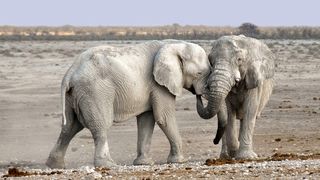Grief
Do Animals Feel Grief?
Cats, dogs, and other animals show evidence of grieving.
Posted February 1, 2019 Reviewed by Davia Sills

In an earlier blog post, I staged a debate between an advocate claiming that nonhuman animals have emotions and a skeptic arguing that there are simpler explanations of animal behavior. I did not declare a winner in the debate, because I was not swayed by either line of argument. However, a book by Barbara J. King from 2013 has convinced me that animals besides humans undergo grief, making it more plausible that they experienced many other emotions.
What is the logic of inferring that an entity has a kind of mental process such as an emotion? It would be elegant if we could give a deductive argument using a general principle:
If an animal has characteristic X, then it has emotion.
But no such definitive criteria exist. Perhaps probability theory could be used to judge whether an animal has an emotion, in line with Bayes' theorem:
P (emotion | evidence) = P (emotion) * P (evidence | emotion) / P (evidence)
But the required probabilities are unknown.
The appropriate logic for assigning emotions and other mental processes to animals and other entities is from inference to the best explanation. We need to determine whether attributing emotions to animals is the best explanation of their behavior, taking into account alternative explanations of the relevant evidence as well as deeper explanations of why animals feel emotions. These deeper explanations would use what is known about psychological and neural mechanisms to explain why animals grieve. Another contributor to the overall explanatory coherence of hypotheses that animals grieve is an analogy between the explanations used for well-established human grief and animal grief.
According to Marc Bekoff (2007), animals show universal signs of grief in responding to the death of a mate, family member, or friend. Like humans, grieving animals may withdraw and seek exclusion, sit motionlessly, lose interest in eating and sex, become obsessed with the dead individual, try to revive the individual, and remain with the carcass for days. These behaviors can all be explained by the hypothesis that the animals are grieving.
King provides abundant examples of grief behavior in animals across many species, including cats, dogs, horses, rabbits, elephants, monkeys, chimpanzees, birds, dolphins, and whales. She also has examples of cross-species grief between pets and their owners, and even between a dog and an elephant.
For simpler emotions, such as happiness and fear, there are alternative explanations of behavior, such as that a dog only seems happy because of a reward mechanism, or that a cat only seems afraid because of threat reactions. But grief behavior does not seem to be explainable by such simple mechanisms since it requires more complicated recognitions of attachment and loss.
What are the psychological mechanisms underlying grief? King thinks that humans and other animals grieve when they have loved. Animals who feel love for another go out of their way to be near to and interact with the loved one for reasons that go beyond mere survival. When animals are no longer able to spend time together because of death or separation, the loving animal will visibly suffer and act in ways that convey sadness.
The neural mechanisms for attachment and sadness are beginning to be understood. There is no single brain area for love or for sadness because all emotions require the interactions of numerous brain areas, such as the amygdala, orbitofrontal cortex, and striatum. All mammals have the same brain areas that underlie human emotions, while birds have different structures that seem to generate similar emotions. Mammals and birds all have neural mechanisms for representation, binding, competition, appraisal, and perception of bodily changes that I argue are responsible for brains having emotions (Thagard, 2019).
I conclude that nonhuman animals do experience grief, because:
- The hypothesis that animals grieve explains many cases of grief-like behavior.
- There are no plausible alternative hypotheses that explain this behavior.
- Known psychological and neural mechanisms operating in humans and other animals causally explain how grief comes about.
This kind of reasoning does not apply to all the emotions that have been assigned to animals. For example, the hypothesis that dogs experience guilt has been debunked by experiments finding that dogs show similar behaviors, such as putting their paws over their heads, regardless of whether they have actually done something wrong. So the alternative hypothesis of defensiveness is more plausible than assigning the complex emotion of guilt. Similarly, I see no reason to attribute to nonhuman animals other complex states, such as mixed emotions (e.g., feeling happy and sad at the same time) and nested emotions (e.g., fear of embarrassment).
In contrast, the conclusion that animals experience grief by virtue of their psychological and neural mechanisms makes it highly plausible that they experience many other simpler emotions, such as happiness, sadness, fear, anger, and surprise.
References
Bekoff, M. (2007). The emotional lives of animals. Novato, CA: New World Library.
King, B. J. (2013). How animals grieve. Chicago: University of Chicago Press.
Thagard, P. (2019). Brain-mind: From neurons to consciousness and creativity. New York: Oxford University Press.




